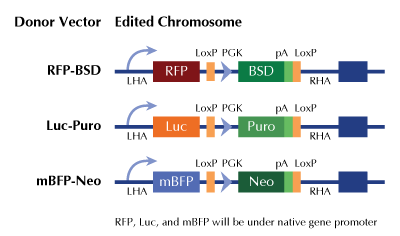TIFA Human Gene Knockout Kit (CRISPR)
CAT#: KN204357RB
TIFA - human gene knockout kit via CRISPR, HDR mediated
Functional Cassette: GFP-puro Luciferase-Puro mBFP-Neo
HDR-mediated knockout kit validation
USD 1,657.00
4 Weeks*
Specifications
| Product Data | |
| Format | 2 gRNA vectors, 1 RFP-BSD donor, 1 scramble control |
| Donor DNA | RFP-BSD |
| Symbol | TIFA |
| Locus ID | 92610 |
| Components |
KN204357G1, TIFA gRNA vector 1 in pCas-Guide CRISPR vector KN204357G2, TIFA gRNA vector 2 in pCas-Guide CRISPR vector KN204357RBD, donor DNA containing left and right homologous arms and RFP-BSD functional cassette. GE100003, scramble sequence in pCas-Guide vector |
| Disclaimer | These products are manufactured and supplied by OriGene under license from ERS. The kit is designed based on the best knowledge of CRISPR technology. The system has been functionally validated for knocking-in the cassette downstream the native promoter. The efficiency of the knock-out varies due to the nature of the biology and the complexity of the experimental process. |
| Reference Data | |
| RefSeq | NM_052864 |
| UniProt ID | Q96CG3 |
| Synonyms | T2BP; T6BP; TIFAA |
| Summary | This gene encodes an adapter protein involved in adaptive and innate immunity. This protein includes a forkhead-associated (FHA) domain that specifically binds to phosphorylated serine and threonine residues. In response to bacterial infection, the encoded host cell protein undergoes an intermolecular interaction between the FHA domain and a phosphorylated threonine that leads to protein oligomerization and stimulation of the NF-kappa B and other downstream signaling pathways. This protein exhibits reduced expression in hepatocellular carcinoma and may suppress hepatocellular carcinoma progression. This protein may also play a role in the DNA damage response. [provided by RefSeq, Jun 2018] |
Documents
| Product Manuals |
| FAQs |
| SDS |
Resources
Other Versions
| SKU | Description | Size | Price |
|---|---|---|---|
| KN204357 | TIFA - human gene knockout kit via CRISPR, HDR mediated |
USD 1,657.00 |
|
| KN204357BN | TIFA - human gene knockout kit via CRISPR, HDR mediated |
USD 1,657.00 |
|
| KN204357LP | TIFA - human gene knockout kit via CRISPR, HDR mediated |
USD 1,657.00 |
|
| KN404357 | TIFA - KN2.0, Human gene knockout kit via CRISPR, non-homology mediated. |
USD 1,657.00 |
|
| GA114228 | TIFA CRISPRa kit - CRISPR gene activation of human TRAF interacting protein with forkhead associated domain |
USD 1,657.00 |
{0} Product Review(s)
Be the first one to submit a review






























































































































































































































































 Germany
Germany
 Japan
Japan
 United Kingdom
United Kingdom
 China
China
